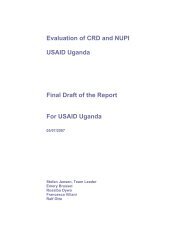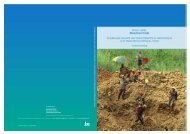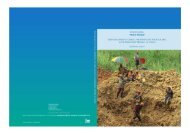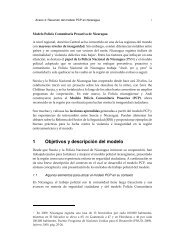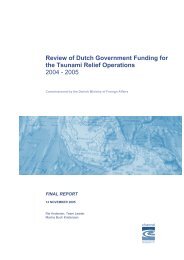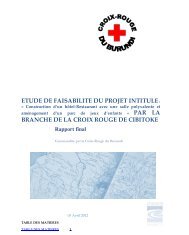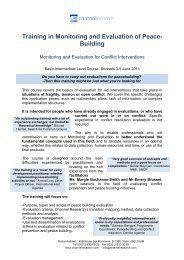A ripple in development? - Channel Research
A ripple in development? - Channel Research
A ripple in development? - Channel Research
Create successful ePaper yourself
Turn your PDF publications into a flip-book with our unique Google optimized e-Paper software.
Changes <strong>in</strong> vulnerability to risk are determ<strong>in</strong>ed by changes <strong>in</strong>:<br />
• Livelihoods (reduced vulnerability through better shelter and better<br />
livelihoods); here our f<strong>in</strong>d<strong>in</strong>gs <strong>in</strong> the other chapters would <strong>in</strong>dicate<br />
the vulnerability has rema<strong>in</strong>ed as high.<br />
• The social fabric (for example the way <strong>in</strong> which people ‘look out for<br />
each other’ and circulate any <strong>in</strong>formation that they have heard about<br />
threats); this has improved <strong>in</strong> connection with the disaster <strong>in</strong> the<br />
Maldives and <strong>in</strong> Indonesia.<br />
• The role of the state civil society (for example, the new <strong>in</strong>terest of<br />
the state <strong>in</strong> reduc<strong>in</strong>g disaster risks even for places that undergo regular<br />
flood<strong>in</strong>g, or the rise of community based organisations);a more<br />
empowered state, especially at the local level as <strong>in</strong> Indonesia, would<br />
<strong>in</strong>dicate lower vulnerability.<br />
• Local capacity (for example, know<strong>in</strong>g who to call to get <strong>in</strong>formation<br />
about river levels upstream); this evaluation would <strong>in</strong>dicate that this<br />
has rema<strong>in</strong>ed weak.<br />
Several officials from the disaster risk reduction <strong>in</strong>stitutions <strong>in</strong> each one<br />
of the three countries commented on concerns about <strong>in</strong>creased levels of<br />
hazard driven by climate change. This <strong>in</strong>cludes the hazard posed by<br />
sea-level rise, changes <strong>in</strong> ra<strong>in</strong>fall patterns and <strong>in</strong>tensity, and changes to<br />
the pattern of tropical cyclones. Two types of processes that could be<br />
seen as chang<strong>in</strong>g vulnerability are:<br />
1. Planned disaster risk reduction <strong>in</strong>terventions.<br />
2. Other aspects of the relief and recovery operation.<br />
The first type of process could be seen <strong>in</strong> the work on the tsunami warn<strong>in</strong>g<br />
centres, and <strong>in</strong> the creation of Disaster Management Centres<br />
throughout Sri Lanka. It could also be seen <strong>in</strong> the efforts to model Sri<br />
Lanka’s rivers to avoid damag<strong>in</strong>g flash floods, and to develop build<strong>in</strong>g<br />
regulations suitable for landslide areas. One of the biggest planned<br />
changes <strong>in</strong> vulnerability may be due to the relocation of people away<br />
from the seashore where the ma<strong>in</strong> hazard may not be tsunamis but<br />
cyclones and storm surges. 80<br />
The second type of process sometimes decreased vulnerability, but<br />
occasionally <strong>in</strong>creased it. Examples of <strong>in</strong>creased vulnerability occurred<br />
where resettlement sites were ill chosen and people found themselves at<br />
risk of flood<strong>in</strong>g, or without services such as water that <strong>in</strong>creased their<br />
risk of illness, or so far from their former livelihoods that they were forced<br />
to change, los<strong>in</strong>g the benefits of some of the capacities that they held.<br />
80<br />
Many shelter projects had already begun before the buffer zone policy was reversed. While some<br />
of those liv<strong>in</strong>g on the sea-shore were do<strong>in</strong>g so for livelihood reasons, others did so because of the<br />
lack of other land for hous<strong>in</strong>g. The overall effect <strong>in</strong> Sri Lanka has been a net movement of population<br />
away from the shore.<br />
94




